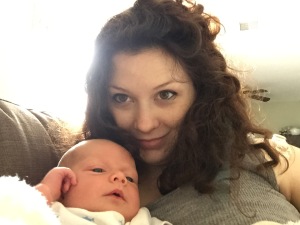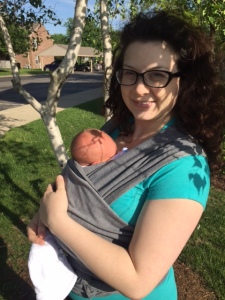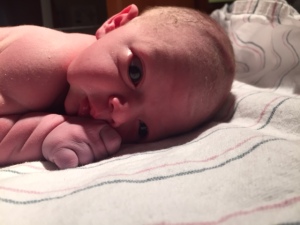Well, folks, baby Zeke (Ezekiel) has finally arrived (May 20) and your home-couple, Boaz and Ruth, couldn’t be more thrilled!
In the past five weeks, we’ve been establishing feeding routines and learning how to deal with the unexpected joys and difficulties of parenting a newborn that needs us 24/7!
A lot of friends have wondered how we’re making it work financially with a baby, especially since my job at a private school as a marketing assistant doesn’t pay millions and Boaz only made something in the low-4-digits this year as a grad assistant and while working another part-time job.
For those of you contemplating young parenthood, I thought I’d put together a post with a few tips we’ve learned along the 9-month-plus way:
- Save Early.
Can’t say it enough. Boaz and I made sure when we married that we’d try to not touch certain funds in the event of a baby; I also set up a monthly automatic transfer in my bank account that was pretty modest, but which, over the nearly four years of our marriage, helped grow my savings account in a way that didn’t pinch later. I’m glad we have it now, since the medical bills are sure to be insane, despite my ‘natural’ childbirth in the hospital (meaning, no meds, no epidural, no surgical/device interventions… you’d think it’d be cheaper, right? Still had the baby in hospital…so, no. #AmericanHealthcareProblems)
- Don’t Snub Heirlooms or Hand-Me-Downs.
Grandma has held on to that cradle for a reason, and so long as it isn’t unsafe by modern standards, make use of it; we certainly did! (By the way, Ababy.com actually will cut a custom mattress to refurbish an old cradle!) Same goes for that friend at work whose children have outgrown their old clothes, toys, books, and other reusable baby accessories. Don’t turn them down, because your baby really won’t care whether he or she spits up on something old, something new, something borrowed (but washable), or whether it’s pink or blue.
- Second-Hand Furniture Saves Cash.
Somewhat in keeping with the above, keep an eye out at consignment stores, Goodwill, and garage sales in the months leading up to your baby’s arrival. I bought a diaper changing table with a few scuff marks on it that at one time came new from Target… for just $25 at a consignment shop where all proceeds from sales go to charity. Hard-surfaced furniture like this is easy to re-sanitize and clean for use again. Remember, too, that the timeline of use for baby furniture is pretty short for most parents: why blow $100-200 on a diaper changing table that will only get used for about 50-60 months between two kids (if you plan on having two?). Even the “look” of furniture that’s wooden or hard-surfaced is flexible; if I want to, I can paint it later to better match a nursery “theme.” I already added storage baskets to its shelves to give me more space to organize, and I think they make it look pretty cute.
- Remember that Friends and Family Love Gifting (Prepare to be Showered).
Lots of women freak out thinking about all the things they will need to buy for their baby. But, like all new brides, they should relax a little: surpassing even wedding showers, your gal pals and lady relatives boast a fascinating passion for buying cute (and necessary!) baby things for your baby shower.
- Control Your Maternity Wear Spending.
I was exceedingly blessed to be working in a school full of female faculty when I announced my pregnancy. I had a math teacher show up at my desk, who, realizing we were close to the same pre-pregnancy size, offered me the use of her maternity wardrobe, realizing that, since she and her husband were likely “done” and her sister-in-law (for whom she’d kept the wardrobe around) likely might snub some of the non-namebrand items, the best use for it in the meantime might be to loan it to me for the few short months in which I’d need the clothes. Awesome!
I wound up only needing to purchase a pair of jeans, a few sweaters, and my own maternity underthings (maternity and nursing bras and larger-waisted panties), in addition to a larger pair of shoes(!) to get by for the rest of my pregnancy, and I did this through both a local Goodwill with a maternity rack and through Target’s clearance sales. Even if the “look” I sported wasn’t quite me, it was still professional enough for work and I felt very comfortable – and grateful—to not have to shell out more money to make outfits appropriate for work wear.
Oh, and I should mention: for workout wear and sleepshirts, I raided my husband’s wardrobe for undershirts, jerseys and even his basketball shorts. It amused him to see some of his larger stuff go over my huge belly, since I kept working out up until my 37th week. My old yoga pants also went surprisingly far into my pregnancy with me, which was a nice surprise!
- Pregnancy Education and Fitness Can Be (Mostly) Free.
When you’re pregnant, you’ll get a lot of invitations from hospitals and even gyms (how do they find out?) via mail and other means that ask you to attend their Childbirth Education/Newborn Care Education/Prenatal Yoga/Prenatal Cardio classes. These classes can cost an arm and a leg.
Luckily, most newborn care education can be found free or mostly free online (YouTube does have some available from reputable sources) and through your local library. I found that for childbirth education, dusting off that old card and picking up some of the old tapes on the Lamaze or Bradley Birthing Methods really worked well. Also, there are a huge amount of books out there on all these topics, and Amazon really helped me score some deals on these.
As a couple, we found that going this route gave us great flexibility: my busy student husband couldn’t make a series of classes consistently with me, but we could carve out some time on weekends to watch a chapter or two of a rented DVD together during his downtime. We also read through several books in bed together.
As far as fitness – There are a TON of prenatal yoga and fitness classes on YouTube! Just be sure that you ask your doctor to advise you about what exercises are appropriate to your stage of pregnancy (hint: if a fitspert asks you to do crunches or other exercises on your back after your first trimester – run!). I was able to keep up with yoga, walking, and even do some safe cardio (elliptical) and weight training (kettle bells are awesome for the pelvic floor) during my pregnancy, just by making use of the equipment at the school where I work and the mat I have at home.
- Shell Out For What’s Most Important – And Save in the Long Run.
There is a very good time and place to spend your money when it comes to preparing for a baby, and that is in preparation for the birth itself! I knew early on that I didn’t want a C-section delivery if I could avoid it, not only because of the long recovery, but also the sticker shock! I also had read enough to convince me that an unmedicated, natural birth was the healthiest route for the baby overall – and would have the shortest recovery time for me, too. But how could I go about securing that, or at least, giving myself the best chances for my best-case scenario? Anything can happen during birth!
Statistically, there was only one element I had read about that really made a difference in what happened in the birthing room: the guidance and presence of a doula, or childbirth coaching professional, who emphasizes the mother’s emotional and physical comfort and applies evidence-based knowledge about birth positions to encourage labor progress. A 2011 Cochrane Review (1) reported the combined findings from 21 randomized controlled trials, including over 15,000 laboring women, which revealed that doula-supported mothers were:
- 28% less likely to have a C-section (with some individual studies reporting upwards of 60%)
- 31% less likely to use synthetic oxytocin (Pitocin) to speed up labor
- 9% less likely to use any pain medication
- 34% less likely to reflect negatively on their childbirth experience
Those are certainly numbers not to ignore! So what did I do?
More research – this time, into the work of local doulas in my area, reading review after review and even meeting some for coffee. To my mind, it would be better to hire a doula to help me (for roughly $1,000), as a first-time mom, to engage in the childbirth process with less fear and with better support, than to simply “go it alone” and rely wholly on the Western-trained US Healthcare system, which has one of the highest C-section rates in the world, and take my chances with a $15,000 C-section bill or the traumatic psychological cost of a childbirthing scenario-turned-nightmare that happens to many women when interventions like Pitocin speed labor beyond the body’s (or baby’s) ability to cope.
Maybe my cost-benefit analysis was flawed, but regardless, I have no regrets.
My DONA-certified (2) doula was an incredible woman with a nursing background who took the time to get to know me before the birth so that we could establish a bond of trust and focus my childbirth preparations on evidence-based practices for labor support and pain management. She came to understand my birthing wishes and was ready and willing to support me in them at the hospital. There were a few times when interventions were offered to me by the hospital staff, with the major one happening when I showed up at the hospital with contractions 3 minutes apart, only to discover that, while 90% effaced, I was still only 2 centimeters dilated (“You could stay, and we could give you something to speed it along…” “No, no thanks.”) I went home instead, and labored in the surroundings of home, where I could drink and eat when I wanted, shower for self-comfort, throw up in privacy when things got intense, shower again, and have my cat for additional company as I paced and swayed with my husband to encourage gravity to move things along.
When I returned to the hospital six hours later, I only had about 2 hours left to go before a bit more walking (which the staff wasn’t keen on me doing, but my doula monitored me during) got me to 9 centimeters—and through the transition stage, nearly ready for pushing. The entire time, my doula was providing comfort measures, showing my husband how to help me get into better positions, and encouraging me to advocate for myself and what I wanted in a situation that otherwise may have felt out of my control.
In this scenario, my sense of control took away my fear. The pain of labor also became less shocking, more normalized, more progressive. Like the frog in the proverbial boiling pot, once I was in labor, even though it grew more intense, I also became increasingly more able to handle each new level of intensity. By the time I thought about maybe, just maybe allowing for some chemical pain intervention, the baby was practically crowning, and I was in the home-stretch (literally, stretch). Again, my doula’s knowledge helped here: after an hour of pushing, she retrieved her rebozo band (similar to a scarf or exercise band), and gave me one end of it to pull on as I simultaneously pushed. With the help of this ancient form of applied mechanical physics, and three more pushes, baby Ezekiel arrived –pink and alert, with a perfect APGAR score, ready to meet us and eager for the breast. I’d never been more exhausted or more glad!
- Breast is Best – for Wallet and Baby.
While formula is arguably more convenient, it’s also expensive and doesn’t carry the benefits of real milk… so I’d encourage any budget-conscious prospective moms out there to prep themselves for breastfeeding if possible. And it DOES take preparation. I’m very glad I didn’t just assume that breastfeeding would come naturally to me; I took the time and took the classes and even saw a lactation consultant in advance (through my doula) who helped me recognize a good vs. bad latch, how to correct or modify a latch, how different holds affect a baby’s latch, and even how to make friends with my breast pump. Days later, when I was in the muzzy, exhausted post-delivery state, when the nurses handed me my baby, I knew what to do to establish good feeding practices from the start and recognize bad ones. I was happy to know when I was two weeks postpartum that my lactation consultant would still be available to help me (again, through my doula) when I noticed some odd things about Zeke’s latch that eventually led us to discover a tongue-tie, which has since been corrected.
- Prep for the Postpartum.
Lastly, when considering the recovery ahead after birth, I thought long and hard about my family’s history with depression and decided to try to prevent Postpartum Depression if I could. One of the ways I did this was by simply taking daily walks and being sure to spend time with friends and family (this is free); the other way I did this Came with a small cost, but might have saved me heavier costs of therapy and medication: I had my placenta dried and encapsulated to dose myself with during that first month after birth.
Most mammals eat their placentas; so did women in many ancient human cultures. It’s weird but not unheard of–even today.
I’d met many women through my doula who had embraced placentophagy (consumption of the placenta) as a practice and swore by it. Since there are so few actual studies on this practice right now, it was only the very high number of personal anecdotal accounts from people I knew that swayed me. And I have to say that, beyond the weirdness of it (which is diminished when taking placenta in capsule form), the effects of this nutrient and hormone-rich organ seem to have only benefitted me. My energy has been excellent, my post-birth anemia was checked quickly, and my mood had only very temporary lapses (I cried, I got over it, I went on to enjoy my day). Did the cost of encapsulation ultimately save me some money by supporting my overall physical and mental health? I really do think so.
That’s all of my tips for now. I hope some of these ideas were helpful or inspired you in your own pregnancy or pre-pregnancy journey. Thanks for reading!
-Ruth
NOTES:
- Hodnett, E.D.; Gates, S.; Hofmeyr, G.J.; Sakala, C.; Weston, J. “Continuous support for women during childbirth.” Cochrane Database of Systematic Reviews. 2011 Feb 16; (2):CD003766.
Want to know who my doula was, or need details about any other service I mentioned here? Message me; I’m happy to put you in contact!



